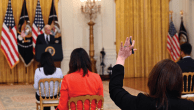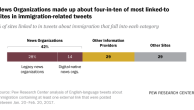One of the persistent criticisms of the coverage from Iraq is there has been too much focus on negative events and not enough on the positive things that were happening.This has been a running theme from the Administration. “For every act of violence there is encouraging progress in Iraq that’s hard to capture on the evening news,” President Bush told a press conference in 2006.
[M]
What do the content findings suggest about this issue?
The question is unlikely to be resolved, no matter what an analysis of the coverage reveals.
What is clear is that a recitation of violence and instability in Iraq permeates the reporting. Most of that came from what was defined as news—daily violence—not how that news was covered.
Does this constitute some unusual slant? Coverage of civil unrest, violence and crime are staples in the general grammar of what constitutes news. It would be natural for journalists to wonder how they could forgo covering such things in Iraq. The findings suggest that journalists were conscious of this. They chose most often to cover the violence in brief. Frequently they did it without trying to draw broad conclusions.
Should the level of coverage from Iraq have decreased as the violence did?
That question may be more difficult to answer. On the one hand, airplane crashes are news, while airplanes landings are not. On the other hand, in the context of the civil strife in Iraq, any change is important, and a decline in violence is change. The survey data suggest that on some level, the public has understood what is occurring from the coverage. As the level of news about violence decreased, the public’s sense of the situation became more positive.
This entire discussion also must take into account the enormous difficulties of trying to cover anything in Iraq beyond parts of Baghdad and a limited number of other locations. One of the clearest findings in our survey of journalists covering the war in Iraq is that the ability of reporters to move around the country freely to get a larger sense of the state of the country is severely limited.
As one broadcast editor put it, “It is dangerous and frustrating. You want to go out and cover stories, but you cannot because of the threat of kidnapping or worse. It’s hard to hear commentators back home say, ‘The media isn’t covering the full story.’ Well, there’s a reason for that, and it’s not bias. And when journalists cannot cover a playground being rebuilt because it’s too dangerous to travel around the city, then that playground is not the primary story.”
Not only are journalists necessarily limited by where they can go and what they can see—what soldiers have often called the fog of war effect—but where matters may be headed, or how to contextualize them, may be even more challenging. If the surge is working, for instance, will that serve the goal of stabilizing the Iraqi government? Or will it have some other effect? For journalists in any setting, elevating daily coverage of rapidly unfolding events into contemporary history, or even solid trends, can prove elusive.

The majority of journalists surveyed who had been reporting from Iraq did not feel the mix of stories, whatever their shortcomings, had made the situation in that country appear worse than the journalists feel that it has been over time.When asked about the picture the press has given of Iraq, 70% say it has been accurate. Another 15% said the press has made the picture look better than it really is, while a 3% said is has focused too much on the negative.
“Overall, the press … have carried out the classic journalistic mission of bearing witness,” one magazine writer said in the PEJ survey. “This means being in places that few other Western eyes saw, and conveying the experiences of both Iraqis and U.S. troops to a larger public.”
In the end, the findings suggest that the coverage has depicted a harrowing situation in Iraq. That level of terror has eased over time. The prospects for what that implies about the future are less certain. People will doubtless argue over whether that is fair.




